About The Artist
Lynne Darrah comes from a long line of tough people - trappers, ranchers, homesteaders, artists and water well drillers. She grew up close to nature and always cared about the land and the animals around her. Her love of the natural world lead to a career in environmental geology.
Now, she paints wild animals, focusing on packs and herds. These animals live in a world that's changing fast, and not always for the better. Their homes are shrinking. People are moving in. Still, she watches them closely , painting them in families, trying to illustrate what makes them resilient in the toughest hour of their history.
Her paintings are bold. The animals stand out. The background fades. It's like the animals are saying, " We're still here".
To Lynne, painting these animals is more than art. It's a way to honor them. They are sacraments.
* Offering commissions
(316) 655-4731
Gallery of Paintings

"Whitetail - Into the Birches"
24" x 48" x 1.5"
Oil on wood
Black floating frame
Sold

" Coyote - Moonlight in Oakbrush"
30" x 40" x 1.5"
Oil on wood
$ 4800
Coyotes are the most successful of all the canids. Smart and adaptable their ranges are increasing even with the expanding population of humans. Look for them in your neighborhood, they are likely there.

" Puma - Leon de Montana "
36" x 36" x 1.5"
Oil on wood
Unframed
Sold
Mountain lions are elusive and solitary. They are powerful beasts able to jump horizontally 40', leap vertically 15', and sprint at 50 mph.
They live in mountains, forests, prairies , deserts and coastal areas all though North and South America. Their main food source is deer and normally kill one every 7-10 days after which they commonly cover or bury their catch. Hunting primarily at night and avoiding humans they are seldom seen without the aid of game cameras.

" Pronghorn on the Blue Mesa "
36" X 64.75 X 1.5"
Oil on panel
Welded steel frame
$ 9216
The Blue Mesa borders the Gunnison River in SW Colorado. The pronghorn there are found in areas of sage and grass. They are a spectacular species with 320 degree vision and the ability to detect movement from a distance of 4 miles. They clock in running at speeds of 60 mph. They rarely drink free water, obtaining most of thier moisture from the plants they eat. Look for them....they are difficult to see....look for their roundish white rumps.

" Mule Deer Does - After the Rut"
36" x 64" x 1.5"
Oil on panel
Painted sides
Unframed
$ 9216
Mule deer are a very curious lot. Instead of turning tail and running like a Whitetail, they look and listen and try to determine what they see and hear. Even after they flee as a herd....they will circle back for a second look or to find a missing member of the herd. The does can be very aggressive towards an adversary even without the presence of a fawn.

"Pronghorn at 9-Mile"
36" X 65" X 1.5"
Oil on panel
Painted wood sides
Sold
Pronghorn antelope are amazing creatures. They can run at speeds of 60 mph for one-half mile and 35 mph for 10 additional miles. Wolf packs cannot catch them but the coyote can. They can go months-years without drinking water, getting all their moisture from the plants they eat. Their tongues are black and they run with their tongues out to breath in more air. The males have manes and long horns while the females have no manes and short horns. Watch for them during blizzards as they may be laying on the road.

" Wolf Pack - Full Winter Coats"
24" x 48" x 1.5"
Oil on wood
Black floating frame
$ 4608
Grey wolves occur in many colors including predominantly red, grey, black or white. The pack usually consists of the alpha pair and 6 more members. The alpha pair mates for life and can live in the wild for up to 16 years. They are highly intelligent and show significant affection for each other. They hunt deer, elk, rabbits and rodents and can eat up to 20 pounds of meat in one session!

" Something in the Spring Fog"
30" x 30" x 1.5"
Oil on wood
Black floating frame
$ 3600
Spring is the most difficult time for does as it's the snowiest time of year and their fat stores are low. But soon the brush will come to life with new stem growth and nutritious leaves. This new growth is devoured by the expectant mother deer and their developing fawns will mature rapidly now. Just as the whole forest is awake....the fawns will arrive.

" Wolf Pack - Watching and Warming"
30" x 40" x 1.5"
Oil on wood
Black floating frame
$ 4800
Grey wolves occur in a variety of colors including black, grey, tan and white. The black ones are a mix of the ancient wolf line existing in North America and dogs brought with humans from Asia over the Alaskan land bridge 11,000 years ago. The black ones are less aggressive than the other colors and they are less prone to distemper. Black colored ones are predominant around the Great Lakes of the US. It is unknown if these crosses were intentional on the part of humans.

" Coyote - All Ears "
24" x 36" x 1.5"
Oil on wood
Black floating frame
$ 3456
Coyotes are a highly successful species. They have adapted to a changing world and have spread beyond there earlier ranges. As wolves declined in the eastern US and possible mates became scarce, coyotes and wolves interbred. The result was a black "coywolf" hybrid. These hybrids now populate the eastern coast of the US. Coyotes may well be in your neighborhood and are even found in NYC's Central Park.
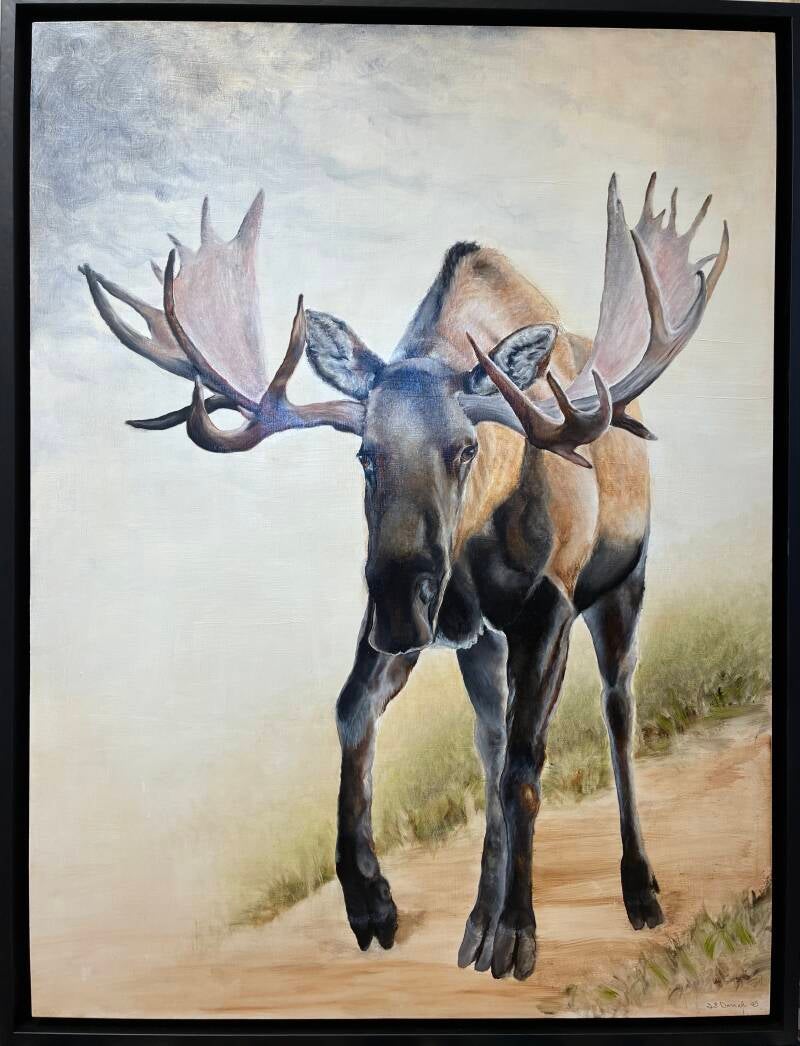
" On The Path Through Town "
30" x 40" x 1.5"
Oil on wood
Black floating frame
$ 4800
Moose were introduced to Colorado in the late 1970's and their numbers are now estimated to be 3500. Their predators are wolves , bears, mountain lions and man. Moose help control the height of willows in riparian areas keeping willow height at about 4-5 ft.
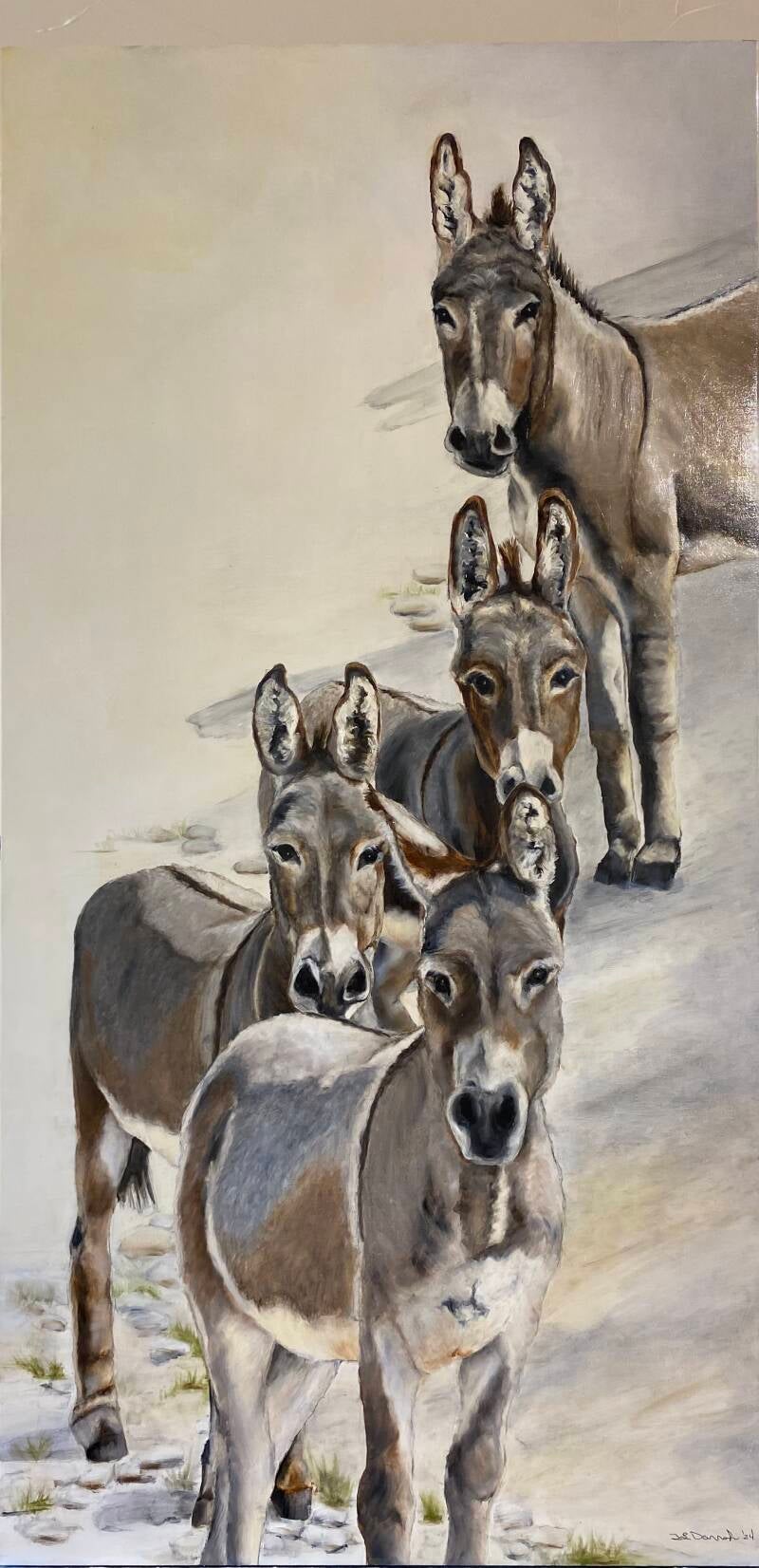
"Into the Arroyo"
24" x 48" x 1.5"
Oil on wood
Black floating frame
$4608
Burros were brought to the new world by the Spaniards. Some were abandoned or escaped and populated northern Mexico and the southwest US. Once free in the Southwest , burros are now held on reservations with fences.
They were historically used as " cars and pickups". They carried the mother of Jesus, have a cross on their backs and are oft called "God's creatures". They thrive in the southwestern US climate where they are neither cold nor wet. They are said to "cry" when cold. They eat low protein vegetation and are made ill by good grass and good hay. This nutritional requirement makes them little competition to humanity's beloved cows and should not be considered by the BLM to be grass competitors. As such, they are rounded up using helicopters and " eliminated" by our federal government.
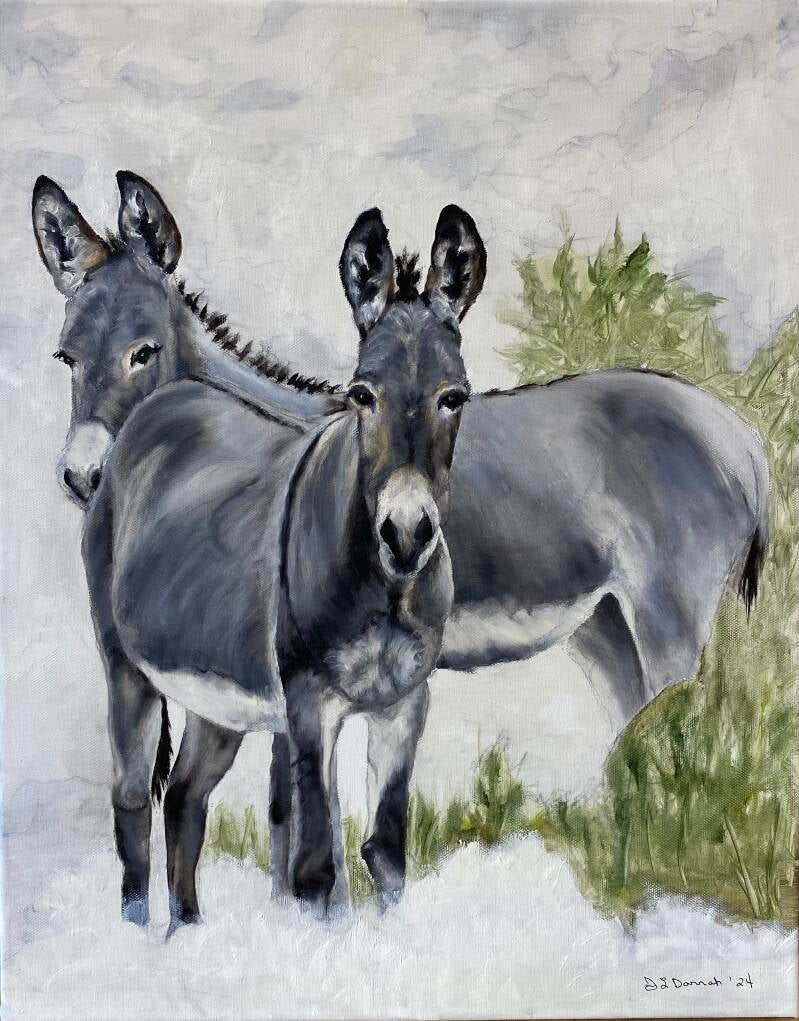
" For Four Hundred Years"
16" x 20"
Oil on canvas
Sold
Burros came to the Americas with the Spanish. Sometimes abandoned, they thrived in the desert southwest. Extremely hardy but adverse to cold and rain, their ancestors have been here....longer than most of our ancestors. The proceeds of the sale of this painting will be directed in whole to the non-profit organization "Wild Horse Education" promoting the cause of wild horses and burros.
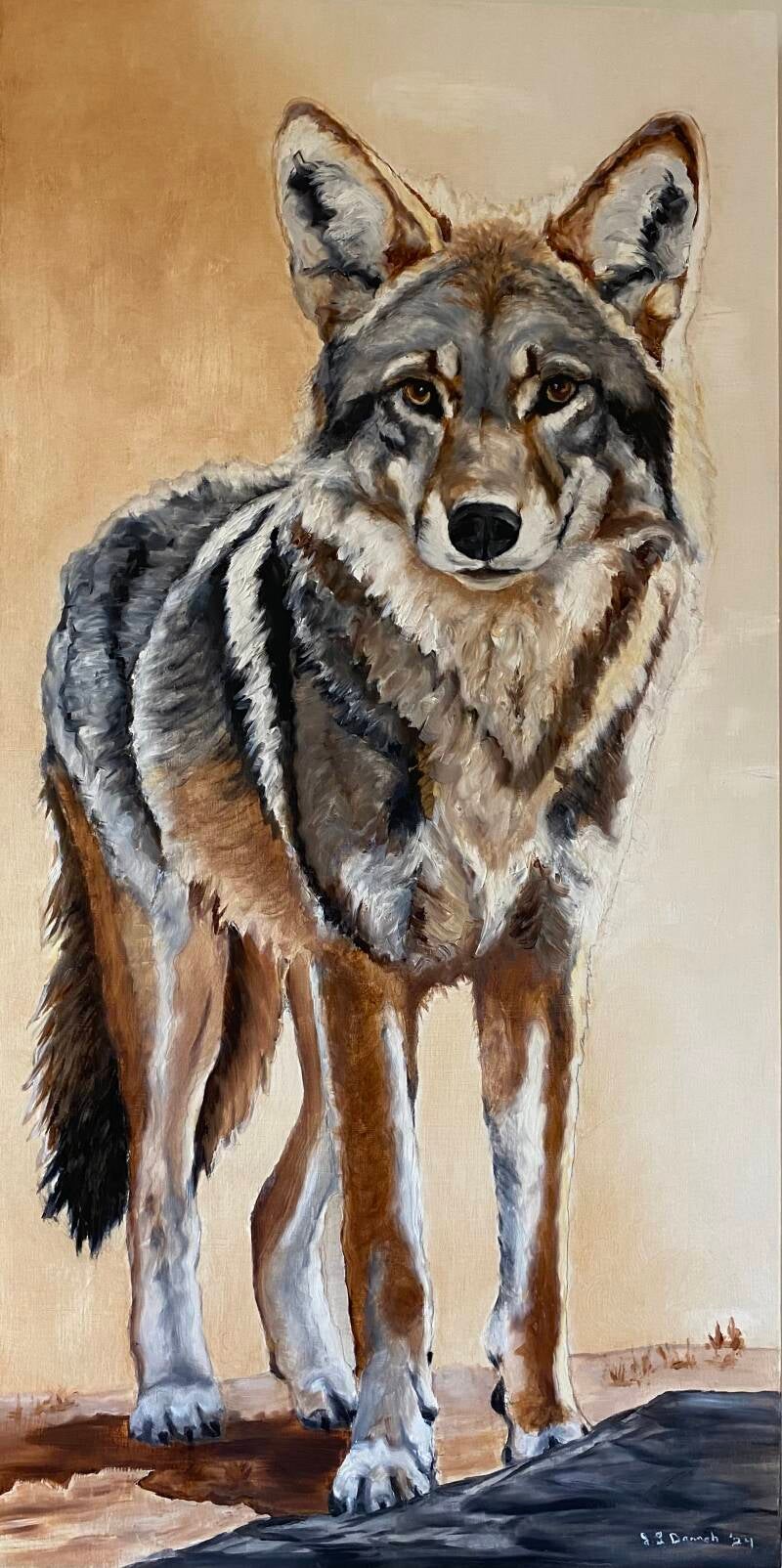
" Desert Life "
18" x 36" x 1.5"
Oil on wood
Black floating frame
$ 2592
Coyotes normally hunt alone but family groups can work together for larger prey. They dine on rabbits, snakes and rodents. Occassionally the family will be successful at taking down a deer or a pronghorn antelope. The coyote is well adapted to mountains, deserts, ranch ground and your neighborhood in town!

" Wolf Pack - 1"
30" x 40"
Oil on canvas
Sold
Out from dark timber and challenged, the pack is nervous.

"A Call to Hunt"
30" x 40" x 1.5"
Oil on wood
Black floating frame
$ 4800
The members of the wolf pack gather in the afternoon as low clouds move in. Snow cover increases the chance of a successful hunt. The group is seasoned at working together. One wolf challenges the prey from the front while others attack from the rear. The alpha pair eats first but all will partake in the spoils.
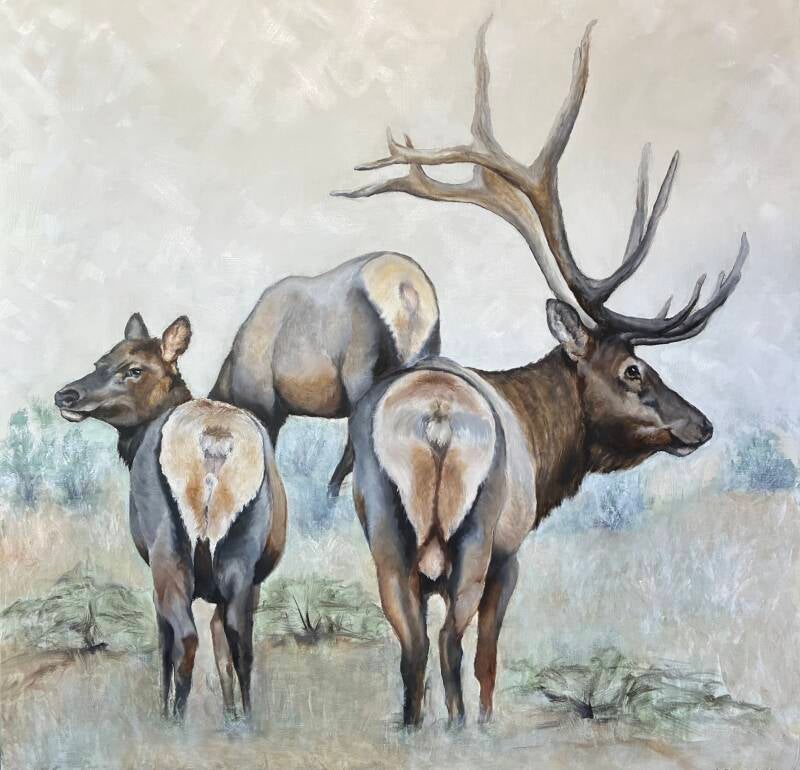
" Out From Dark Timber to Sage"
30" x 30" x 1.5"
Oil on wood
Black floating frame
$ 3600
Elk sleep in dark timber during the day and rise and come out to graze grass growing amongst the sage during the late afternoon. They then sleep in the sage at night and rise the next morning as soon as sunlight touches their hide. Their hair is hollow and sunlight bounces around inside their hair shafts warming the animal. Hollow hair helps keep them warm in winter but hot in the summer season. They move themselves to higher elevation in the summer to avoid the heat at lower elevations. Bulls and cows are found together during the Fall rut.
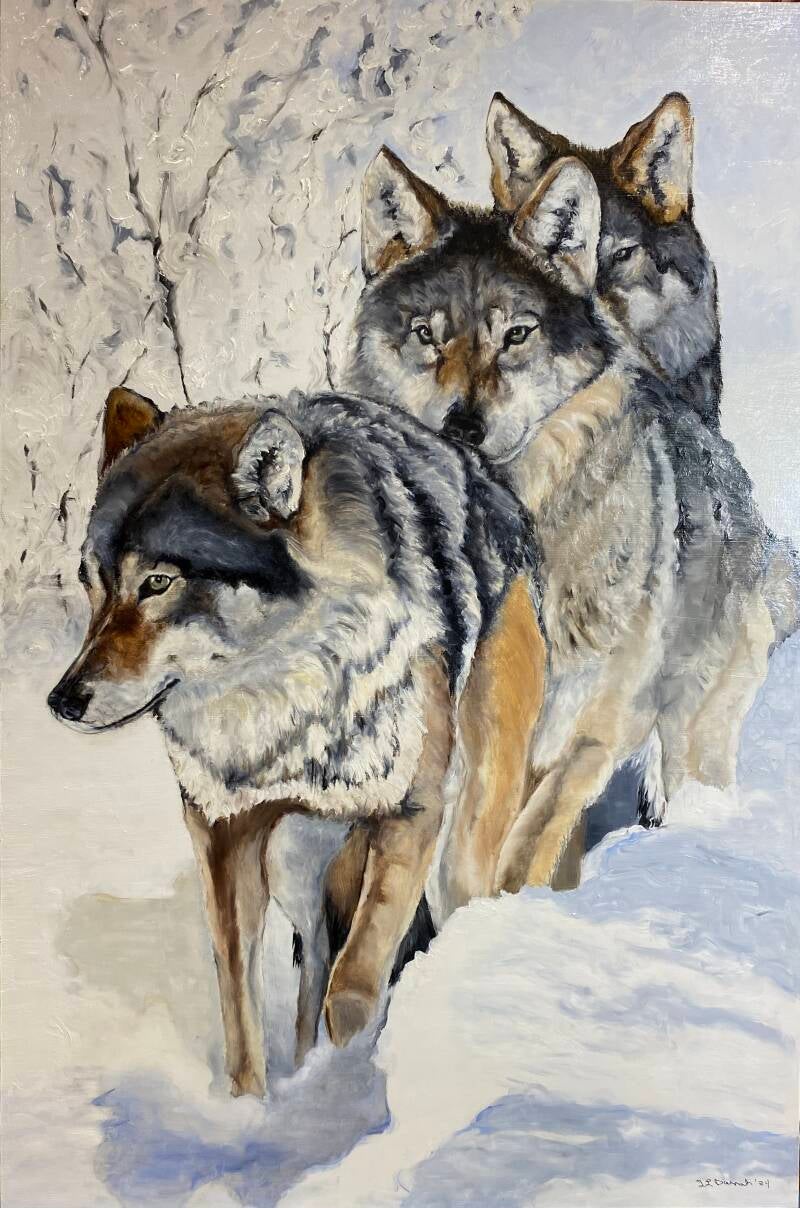
" Three Amigos"
24" x 36" x 1.5"
Oil on wood
Black floating frame
Sold
A well worn path directs the wolf pack towards last nights kill. While prey is weaker in winters snow, the pack becomes stronger as hunting is more successful.

" Evening Songs "
24" x 36" x 1.5
Oil on wood
Black floating frame
Sold
Grey wolves in eastern Canada gather to hunt in the evening. The songs bring in all the hunters and enthusiasm is high.
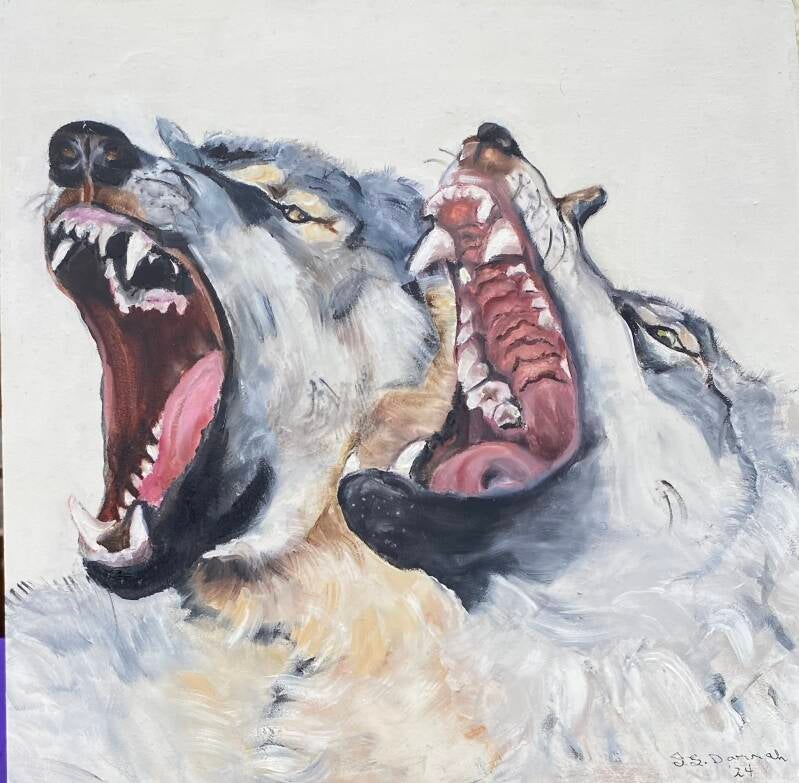
"Beware"
12" x 12" x 2"
Oil on wood
Black floating frame
Sold
These wolves are informing all near to them that they are taking the situation very seriously.
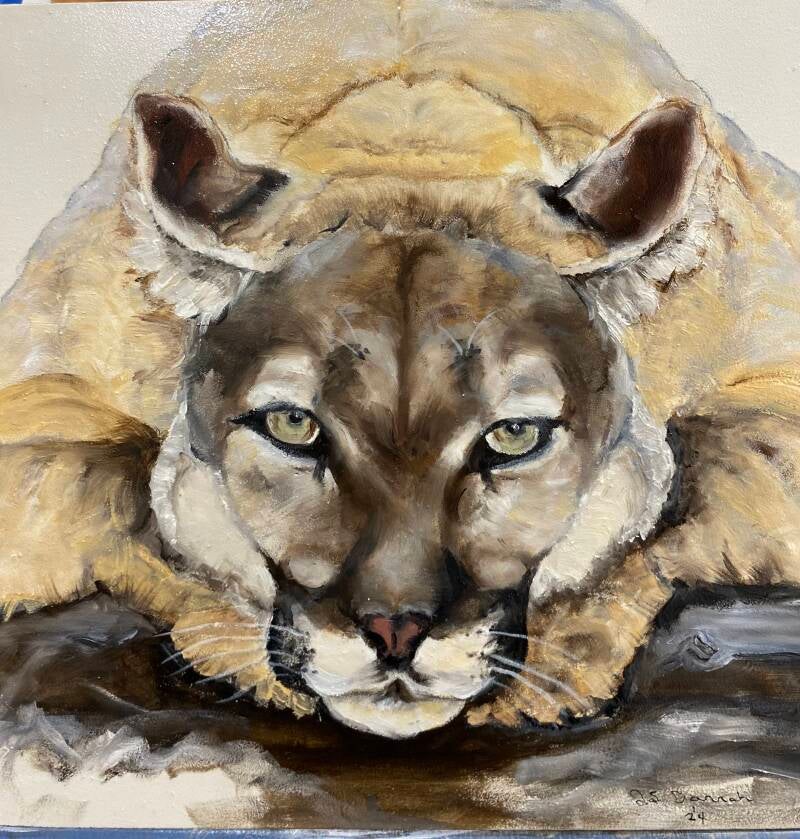


" The Three Faces of Eve " - The Series
(3) Separate 12" x 12" x 2" paintings
Oil on wood
Natural wood sides
Sold
The movie "The Three Faces of Eve" was released in 1957. It was based on a true story of a woman with a fractured personality. The fracture was caused by a childhood trauma. The personalities were Eve White, Eve Black and Jane. With therapy the woman was cured and lead a normal life. These mountain lions depict that fractured personality.

" Rabbit Down "
12" x 12" x 2"
Oil on wood
$ 576
Repeatedly pouncing on the rabbit in the grass is an effective hunting method used by coyotes. Rabbits are commonly hunted by coyotes.

" I See You "
18" x 36" x 1.5"
Oil on wood
Natural wood sides
Sold
Coyotes are well adapted to live in many different environments from deserts to urban settings. This coyote lives in Arizona.

" Brotherly Love "
16" x 24" x 2"
Oil on gesso board
Natural wood sides
Sold
Two Russian wolves play and practice being wolves

" Clever Fox Boy "
15" x 30" x 1.5"
Oil on wood
Black floating frame
Sold
Smart and bold foxes are beloved by man. As their rural habitat shrinks, fox populations are increasing in urban areas. Because they are nocturnal, many people are unaware that fox are in their neighborhoods.

" Always Hungry "
18" x 36 " x 1.5"
Oil on wood
Natural wood sides
$ 2592
Solitary and magestic, mountain lions avoid humans and prefer to hunt deer. They hunt mostly at night. If you are hiking ..... keep an eye out ....you might see one sleeping in a tree.

" Ready "
12" x 12" x 2"
Oil on gesso board
Natural wood sides
Sold
Claws out, poised to jump. It's unlikely the prey even knows the mountain lion is there.